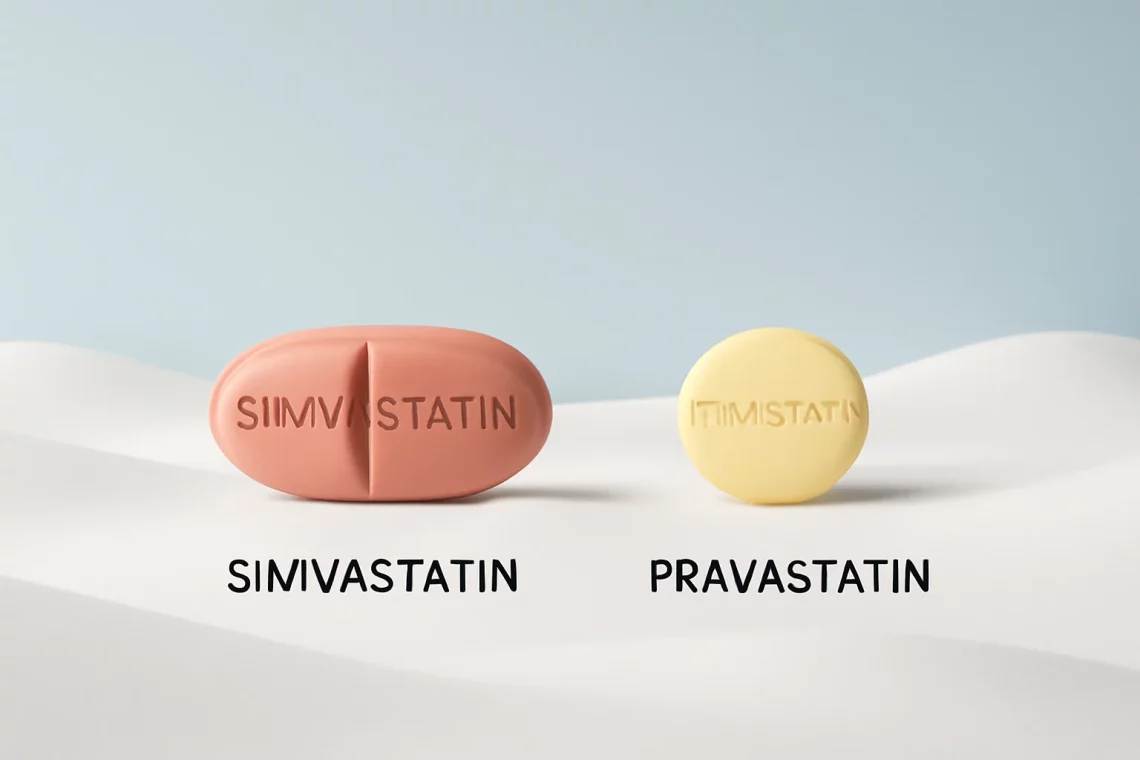
Simvastatin vs Pravastatin: Which Statin Is Right for You?
Cholesterol management is a vital aspect of maintaining heart health, especially in an age where lifestyle diseases are on the rise. Among the various medications available to manage cholesterol levels, statins are among the most commonly prescribed. Simvastatin and pravastatin are two prominent members of this drug class, known for their effectiveness in lowering low-density lipoprotein (LDL) cholesterol, often referred to as “bad” cholesterol. Both medications work by inhibiting an enzyme that plays a central role in cholesterol production in the liver, thus helping reduce the overall cholesterol levels in the bloodstream.
Understanding the nuances between simvastatin and pravastatin can empower patients and healthcare providers to make informed decisions tailored to individual health needs. While both drugs share a similar mechanism of action, they exhibit differences in their pharmacokinetic profiles, potential side effects, and drug interactions. This article delves into a comparative analysis of simvastatin and pravastatin, exploring their effectiveness, safety, and suitability for various patient populations. By evaluating these factors, patients can better navigate their treatment options, ensuring they receive the best possible care for their cholesterol management.
Understanding Statins: The Basics
Statins are a class of medications that are primarily used to lower cholesterol levels in the blood. They achieve this by inhibiting the enzyme HMG-CoA reductase, which is crucial for the production of cholesterol in the liver. By doing so, statins effectively reduce the levels of LDL cholesterol, which is linked to an increased risk of heart disease and stroke. Besides lowering LDL cholesterol, statins also have other beneficial effects on cardiovascular health, including modest increases in high-density lipoprotein (HDL) cholesterol, known as the “good” cholesterol, and a reduction in triglycerides.
Simvastatin and pravastatin are two commonly prescribed statins. They are often chosen based on individual patient profiles, including factors such as age, existing health conditions, and potential interactions with other medications. Simvastatin is known for its potency and is typically prescribed for patients with significantly elevated cholesterol levels or those who have experienced cardiovascular events. On the other hand, pravastatin is generally considered to have a more favorable safety profile, making it a suitable option for patients who may be at risk for side effects.
While both medications are effective in managing cholesterol levels, their differences can influence prescribing practices. For instance, simvastatin is often more effective at lower doses for reducing LDL cholesterol, but it may come with a higher risk of muscle-related side effects, such as myopathy or rhabdomyolysis. Pravastatin, while slightly less potent in lowering LDL cholesterol, has a lower incidence of these side effects, making it a safer choice for certain patient populations.
It is crucial for patients to engage with their healthcare providers to determine which statin is the most appropriate for their specific health needs. Understanding the fundamental workings of these medications can help patients feel more informed and confident in their treatment plans.
Comparative Effectiveness: Simvastatin vs. Pravastatin
When comparing the effectiveness of simvastatin and pravastatin, several studies have highlighted their roles in managing cholesterol levels and reducing cardiovascular risks. Simvastatin is often regarded as a more potent statin, particularly in its ability to lower LDL cholesterol levels. Clinical trials have shown that simvastatin can reduce LDL cholesterol by approximately 20-60%, depending on the dosage. This makes it a popular choice for patients with severe hyperlipidemia or those with a history of cardiovascular events.
Pravastatin, while slightly less potent, has demonstrated effectiveness in lowering LDL cholesterol by about 15-40%. However, its unique pharmacological properties allow it to be a suitable option for patients who may be more susceptible to the side effects associated with other statins. Moreover, pravastatin has been shown to have a favorable effect on cardiovascular outcomes, which is a critical consideration when selecting a statin for long-term use.
Another factor to consider is the drug interactions associated with each statin. Simvastatin is known to interact with a broader range of medications, which can increase the risk of side effects. For instance, patients taking certain antibiotics or antifungals may need to avoid simvastatin to prevent serious muscle-related complications. In contrast, pravastatin has fewer drug interactions, making it a safer choice for patients with complex medication regimens.
Ultimately, the choice between simvastatin and pravastatin should be guided by a patient’s individual health profile, including their cholesterol levels, risk factors for cardiovascular disease, and potential medication interactions. Both medications have their benefits, and a thorough discussion with a healthcare provider can help ensure the best therapeutic outcomes.
Side Effects and Safety Profiles
Both simvastatin and pravastatin, like all medications, come with their own set of potential side effects. Understanding these can help patients make informed choices about their cholesterol management.
Simvastatin is associated with a higher risk of muscle-related side effects, which can range from mild discomfort to severe conditions like rhabdomyolysis. Symptoms of muscle problems may include unexplained muscle pain, tenderness, weakness, or a fever. Patients taking simvastatin should be closely monitored, especially if they are also using medications that can increase the risk of these side effects.
Pravastatin, on the other hand, tends to have a better safety profile in terms of muscle-related issues. While it is not entirely free from side effects, the incidence of muscle pain and damage is notably lower compared to simvastatin. This characteristic makes pravastatin a more favorable option for older adults or those with pre-existing conditions that increase the risk of muscle-related side effects.
In addition to muscle problems, both medications may cause gastrointestinal issues such as nausea, diarrhea, or constipation. These side effects are generally mild and transient. However, if they persist, patients are encouraged to consult their healthcare provider.
It is also important to note that both medications can affect liver function. Regular monitoring of liver enzymes is recommended for patients taking statins, especially during the initial months of treatment. If liver enzyme levels rise significantly, healthcare providers may need to adjust the dosage or even discontinue the medication.
Ultimately, while both simvastatin and pravastatin are effective in managing cholesterol, their differing safety profiles and side effects should be carefully considered when prescribing. Patients should always communicate openly with their healthcare providers about any side effects they experience to ensure optimal management of their cholesterol levels.
Choosing the Right Statin for You
Deciding between simvastatin and pravastatin is a decision that should be made collaboratively between a patient and their healthcare provider. Several factors come into play, including the specific cholesterol levels, overall health status, and any other medications being taken.
For patients with significantly elevated LDL cholesterol or those with a history of heart disease, simvastatin may be the preferred choice due to its potency. However, for individuals who may be at higher risk for muscle-related side effects or those on multiple medications, pravastatin may be a safer option.
Lifestyle factors also play a crucial role in cholesterol management. Regardless of the chosen statin, patients are encouraged to adopt heart-healthy habits such as maintaining a balanced diet, engaging in regular physical activity, and avoiding tobacco products. These lifestyle modifications can enhance the effectiveness of statin therapy and contribute to overall cardiovascular health.
Moreover, regular follow-up appointments are essential to monitor cholesterol levels, assess side effects, and make any necessary adjustments to the treatment plan. Patients should feel empowered to discuss their concerns and preferences regarding statin therapy with their healthcare providers, as a personalized approach is key to successful cholesterol management.
In conclusion, both simvastatin and pravastatin are effective statins that can aid in managing cholesterol levels and reducing cardiovascular risk. By understanding their differences and working closely with healthcare providers, patients can choose the medication that aligns best with their health goals and needs.
**Disclaimer:** This article is for informational purposes only and does not constitute medical advice. Always consult your healthcare provider for any health-related concerns or before making changes to your medication regimen.




